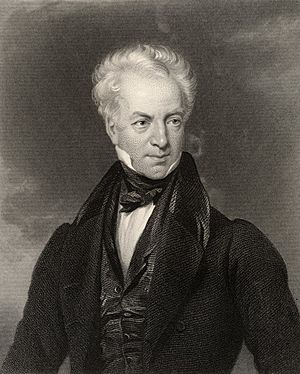John Baron (physician) facts for kids
John Baron (1786–1851) was an English doctor. He is best known for writing the life story of Edward Jenner, the famous doctor who developed the vaccine for smallpox.
Contents
About John Baron
Early Life and Education
John Baron was born in St. Andrews, Scotland, in 1786. His father was a professor at the university there. When John was fifteen, he went to Edinburgh to study medicine. He earned his medical degree (M.D.) just four years later, in 1805, at the young age of nineteen.
Career and Health Challenges
After finishing his studies, Baron spent two years in Lisbon, Portugal, caring for a patient. When he returned, he started his medical practice in Gloucester, England. He became one of the doctors at the General Infirmary and built a successful practice in the area.
However, in 1832, John Baron became very ill after getting cholera. This illness forced him to stop working. He then moved to Cheltenham, where he lived for the rest of his life. In his later years, he suffered from a condition called 'creeping palsy,' which made it hard for him to move.
Helping Others
Even with his own health problems, Baron was dedicated to helping others. He was one of the first to support more humane treatment for people with mental health conditions at the Gloucester asylum. He also helped start the Medical Benevolent Fund, which supported doctors in need. He was a strong supporter of the Medical Missionary Society of Edinburgh, which sent doctors to help people around the world. John Baron passed away in 1851.
Friends and Connections
John Baron had several important friends. One was Dr. Matthew Baillie, a well-known doctor who lived near Cirencester. Another close friend was Edward Jenner, who practiced medicine about sixteen miles from Gloucester.
John Baron's Writings
The Life of Edward Jenner
John Baron met Edward Jenner around 1809. After Jenner's death in 1823, Baron was chosen to write his biography. He received many of Jenner's personal notes and letters. It took him a long time, but his book, Life of Edward Jenner, M.D., LL.D., F.R.S., with Illustrations of his Doctrine and Selections from his Correspondence, was finally finished in 1838. It was published in two volumes and included pictures. The book also told the story of how vaccination became widely used.
Views on Vaccination
Baron greatly admired Jenner and fully supported his ideas. In 1839, he wrote a report on vaccination for a medical association. Some people criticized this report. They felt that Baron accepted Jenner's ideas about how long vaccinations would protect people without enough proof. A doctor named George Gregory also questioned how Baron used statistics in his report.
Studies on Tubercles
John Baron also wrote three books about 'tubercles.' These were small lumps or growths that doctors found in the body, especially in the lungs.
- Enquiry illustrating the Nature of Tuberculated Accretions of Serous Membranes, published in 1819.
- Illustrations of the Enquiry respecting Tuberculous Diseases, published in 1822.
- Delineations of the Changes of Structure which occur in Man and some of the Inferior Animals, published in 1828.
His work in understanding diseases, known as pathology, led to him becoming a member of the Royal Society in 1823. This is a very respected group of scientists.
Baron's ideas about tubercles were based on earlier theories from doctors like Jenner and John Hunter. They believed that tubercles were a type of hydatid (a fluid-filled cyst) that had become solid. However, later doctors like René Laennec showed that this theory was not correct. Even though his specific theory about tubercles was later disproven, his studies contributed to the understanding of diseases.


